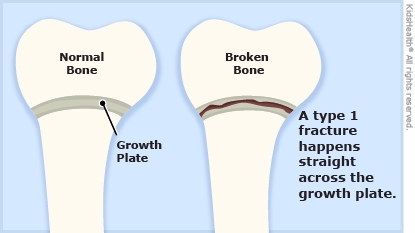The growth plate is a layer of cartilage near the end of a bone where most of the bone's growth happens. There are several types of growth plate fractures. Your child has a type 1 growth plate fracture, which is the mildest type. With proper care, this type of fracture heals within a month or so and does not affect the bone's growth.
Your child has a cast to hold the bone in place while it heals. Take care of the cast and treat pain as instructed to keep your child comfortable while healing.

Follow your health care provider's recommendations for:
- Caring for the cast
- Using crutches, if needed
- What activities to avoid (such as sports)
- When to follow up
To help with pain and swelling:
- You can give medicine, such as acetaminophen (Tylenol® or a store brand) or ibuprofen (Advil®, Motrin®, or a store brand). Follow the package directions for how much to give and how often.
- When your child is awake, put ice in a plastic bag wrapped in a towel on the area for 20 minutes a few times a day. Don't put ice directly on the skin.
- Prop up the injured area on pillows when your child is sitting down or sleeping.
Cast care:
- Make sure the cast isn't too tight. It shouldn't feel uncomfortable to your child. If the fingers or toes near the cast look puffy, raise the injured area above the level of the heart for 1 hour.
- Make sure the skin around the cast area isn't scratched or irritated. For sharp cast edges, put tape or moleskin (available at drugstores or online) on any rough spots.
- If the area under the cast is itchy, tap lightly on the cast or use a hair dryer on the cool setting to blow air in and around the edges. Make sure your child doesn't pick at or scratch under the cast.
- Don't put anything into the cast. Make sure your child doesn't put toys, food, or anything else into it.
- Keep dirt, sand, lotion, and powder away from the cast.
- Keep the cast dry:
- No swimming.
- Younger children can get a sponge bath. For regular baths or showers, you can cover the cast in one of these ways:
- Two plastic bags sealed at the top with a rubber band or tape
- Plastic wrap covered with a plastic bag that is sealed at the top
- A waterproof cast protector
- If the cast gets splashed, blow air into it from a hair dryer on the cool setting.

How does a growth plate fracture happen? Growth plates are weaker than the rest of the bone and more prone to injury. Most commonly, a fracture happens when a growing child falls on or twists an arm or leg (for example, while running, skiing, or skateboarding). Growth plate fractures also can happen from doing the same activity over and over (for example, pitching a baseball or training for gymnastics).
How is a growth plate fracture diagnosed? Health care providers will order X-rays if they think a bone is broken. Some growth plate fractures might not show up on an X-ray, though. So even when an X-ray is normal, if a growing child has pain near a growth plate, health care providers often will treat them for a growth plate fracture.




